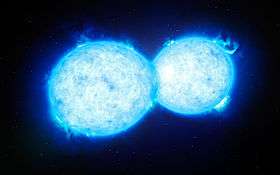Contact binary

In astronomy, a contact binary is a binary star system whose component stars are so close that they touch each other or have merged to share their gaseous envelopes. A binary system whose stars share an envelope may also be called an overcontact binary.[1][2][3] Almost all known contact binary systems are eclipsing binaries;[4] eclipsing contact binaries are known as W Ursae Majoris variables, after their type star, W Ursae Majoris.[5]
Contact binaries are sometimes confused with common envelopes. However, whereas the configuration of two touching stars in a contact binary has a typical lifetime of millions to billions of years, the common envelope is a dynamically unstable phase in binary evolution that either expels the stellar envelope or merges the binary in a timescale of months to years.[6]
See also
- Contact binary (small Solar System body), two asteroids gravitating toward each other until they touch
- Thorne–Żytkow object, a type of star wherein a red giant or supergiant contains a neutron star at its core
- VFTS 352
References
- ↑ contact binary, David Darling, The Internet Encyclopedia of Science. Accessed on line November 4, 2007.
- ↑ overcontact binary, David Darling, The Internet Encyclopedia of Science. Accessed on line November 4, 2007.
- ↑ pp. 51–53, An Introduction to Astrophysical Fluid Dynamics, Michael J. Thompson, London: Imperial College Press, 2006. ISBN 1-86094-615-1.
- ↑ p. 231, Stellar Rotation, Jean Louis Tassoul, Andrew King, Douglas Lin, Stephen P. Maran, Jim Pringle, and Martin Ward, Cambridge, UK, New York: Cambridge University Press, 2000. ISBN 0-521-77218-4.
- ↑ p. 19, Double and Multiple Stars and how to Observe Them, James Mullaney, New York, London: Springer, 2005. ISBN 1-85233-751-6.
- ↑ Ivanova, N.; Justham, S.; Chen, X.; De Marco, O.; Fryer, C. L.; Gaburov, E.; Ge, H.; Glebbeek, E.; Han, Z.; Li, X. D.; Lu, G.; Podsiadlowski, P.; Potter, A.; Soker, N.; Taam, R.; Tauris, T. M.; van den Heuvel, E. P. J.; Webbink, R. F. (2013). "Common envelope evolution: where we stand and how we can move forward". The Astronomy and Astrophysics Review. 21: 59. arXiv:1209.4302
 . Bibcode:2013A&ARv..21...59I. doi:10.1007/s00159-013-0059-2.
. Bibcode:2013A&ARv..21...59I. doi:10.1007/s00159-013-0059-2.